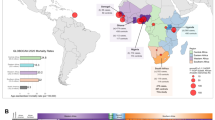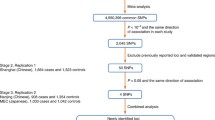Abstract
Intercellular adhesion molecules (ICAMs) are known to be involved in various human cancers. An ICAM gene cluster lying within a 26 kb region on chromosome 19p13.2, and containing ICAM1, ICAM4, and ICAM5 has recently been identified as harboring a breast and prostate cancer susceptibility locus in two populations of European ancestry from Germany and Australia. The objective of this study was to confirm the ICAM association with prostate cancer in a sample of African American prostate cancer cases (N = 286) and controls (N = 391). Six single nucleotide polymorphisms (SNPs) within the three ICAM genes were genotyped. To control for potential population stratification an ancestry-adjusted association analysis was performed. We found that ICAM1 SNPs, −9A/C (rs5490) and K469E (rs5498) were associated with prostate cancer risk in men with a family history of prostate cancer (P = 0.008). Specifically, increased risk was observed for individuals who possessed the CC genotype of the −9 A/C variant (odds ratio = 2.5; 95% CI = 1.0–6.3) and at least one G allele of non-synonymous K469E variant (odds ratio = 1.8; 95% CI = 1.2–3.1). Strong linkage disequilibrium was observed across the ICAM region (P < 0.001). A common haplotype within the ICAM gene cluster, harboring the −9A/C variant was significantly associated with prostate cancer (P = 0.03), mainly due to men with family history (P = 0.01). Our results replicate previous findings of association of the ICAM gene cluster with prostate cancer and suggest that common genetic variation within ICAM1 and not ICAM5 may be an important risk factor for prostate cancer.


Similar content being viewed by others
References
Aalinkeel R, Nair MP, Sufrin G, Mahajan SD, Chadha KC, Chawda RP, Schwartz SA (2004) Gene expression of angiogenic factors correlates with metastatic potential of prostate cancer cells. Cancer Res 64:5311–5321
Abecasis GR, Cookson WO (2000) GOLD—graphical overview of linkage disequilibrium. Bioinformatics 16:182–183
Barnard RJ, Aronson WJ, Tymchuk CN, Ngo TH (2002) Prostate cancer: another aspect of the insulin-resistance syndrome? Obes Rev 3:303–308
Bonilla C, Shriver MD, Parra EJ, Jones A, Fernandez JR (2004) Ancestral proportions and their association with skin pigmentation and bone mineral density in Puerto Rican women from New York city. Hum Genet 115:57–68
Easton D, Schaid D, Whittemore AS, Isaacs WJ (2003) Where are the prostate cancer genes? Summary of eight genome wide searches. Prostate 57:261–269
Eferl R, Wagner EF (2003) AP-1: a double-edged sword in tumorigenesis. Nat Rev Cancer 3:859–868
French DB, Jones LA (2005) Minority issues in prostate disease. Med Clin North Am 89: 805–816
Frenette PS, Wagner DD (1996) Adhesion molecules—Part 1. N Engl J Med 334:1526–1529
Fujihara T, Yashiro M, Inoue T, Sawada T, Kato Y, Ohira M, Nishiguchi Y, Ishikawa T, Sowa M, Chung KH (1999) Decrease in ICAM-1 expression on gastric cancer cells is correlated with lymph node metastasis. Gastric Cancer 2:221–225
Gao AC, Lou W, Ichikawa T, Denmeade SR, Barrett JC, Isaacs JT (1999) Suppression of the tumorigenicity of prostatic cancer cells by gene(s) located on human chromosome 19p13.1–13.2. Prostate 38:46–54
Gardiner EE, D’Souza SE (1999) Sequences within fibrinogen and intercellular adhesion molecule-1 (ICAM-1) modulate signals required for mitogenesis. J Biol Chem 274:11930–11936
Hermand P, Gane P, Huet M, Jallu V, Kaplan C, Sonneborn HH, Cartron JP, Bailly P (2003) Red cell ICAM-4 is a novel ligand for platelet-activated alpha IIbbeta 3 integrin. J Biol Chem 278:4892–4898
Hoggart CJ, Parra EJ, Shriver MD, Bonilla C, Kittles RA, Clayton DG, McKeigue PM (2003) Control of confounding of genetic associations in stratified populations. Am J Hum Genet 72:1492–1504
Hsing AW, Tsao L, Devesa SS (2000) International trends and patterns of prostate cancer incidence and mortality. Int J Cancer 85:60–67
Hsing AW, Chua S Jr, Gao YT, Gentzschein E, Chang L, Deng J, Stanczyk FZ (2001) Prostate cancer risk and serum levels of insulin and leptin: a population-based study. J Natl Cancer Inst 93:783–789
Hubbard AK, Rothlein R (2000) Intercellular adhesion molecule-1 (ICAM-1) expression and cell signaling cascades. Free Radic Biol Med 28:1379–1386
Ioannidis JP, Ntzani EE, Trikalinos TA, Contopoulos-Ioannidis DG (2001) Replication validity of genetic association studies. Nat Genet 29:306–309
Jemal A, Murray T, Ward E, Samuels A, Tiwari RC, Ghafoor A, Feuer EJ, Thun MJ (2005) Cancer statistics. CA Cancer J Clin 55:10–30
Kammerer S, Roth RB, Reneland R, Marnellos G, Hoyal CR, Markward NJ, Ebner F, Kiechle M, Schwarz-Boeger U, Griffiths LR, Ulbrich C, Chrobok K, Forster G, Praetorius GM, Meyer P, Rehbock J, Cantor CR, Nelson MR, Braun A (2004) Large-scale association study identifies ICAM gene region as breast and prostate cancer susceptibility locus. Cancer Res 64:8906–8910
Kittles RA, Chen W, Panguluri RK, Ahaghotu C, Jackson A, Adebamowo CA, Griffin R, Williams T, Ukoli F, Adams-Campbell L, Kwagyan J, Isaacs W, Freeman V, Dunston GM (2002) CYP3A4-V and prostate cancer in African Americans: causal or confounding association because of population stratification? Hum Genet 110:553–560
Long JC, Williams RC, Urbanek M (1995) An E-M algorithm and testing strategy for multiple-locus haplotypes. Am J Hum Genet 56:799–810
Lynch DF Jr, Hassen W, Clements MA, Schellhammer PF, Wright GL Jr (1997) Serum levels of endothelial and neural cell adhesion molecules in prostate cancer. Prostate 32:214–220
Maeda K, Kang SM, Sawada T, Nishiguchi Y, Yashiro M, Ogawa Y, Ohira M, Ishikawa T, Hirakawa-YS Chung K (2002) Expression of intercellular adhesion molecule-1 and prognosis in colorectal cancer. Oncol Rep 9: 511–514
Matsuoka TA, Artner I, Henderson E, Means A, Sander M, Stein R (2004) The MafA transcription factor appears to be responsible for tissue-specific expression of insulin. Proc Natl Acad Sci USA 101:2930–2933
Nishimura M, Naito S (2005) Tissue-specific mRNA expression profiles of human toll-like receptors and related genes. Biol Pharm Bull 28:886–892
O’Hanlon DM, Fitzsimons H, Lynch J, Tormey S, Malone C, Given HF (2002) Soluble adhesion molecules (E-selectin, ICAM-1 and VCAM-1) in breast carcinoma. Eur J Cancer 38:2252–2257
Pritchard JK, Stephens M, Donnelly P (2000) Inference of population structure using multilocus genotype data. Genetics 155:945–959
Rokhlin OW, Cohen MB (1995) Expression of cellular adhesion molecules on human prostate tumor cell lines. Prostate 26:205–212
Rosette C, Roth RB, Oeth P, Braun A, Kammerer S, Ekblom J, Denissenko MF (2005) Role of ICAM1 in invasion of human breast cancer cells. Carcinogenesis 26:943–950
Routh JC, Leibovich BC (2005) Adenocarcinoma of the prostate: epidemiological trends, screening, diagnosis, and surgical management of localized disease. Mayo Clin Proc 80: 899–907
Schaid D (2004) The complex genetic epidemiology of prostate cancer. Hum Mol Genet 13(1):R103-R121
Shirai A, Furukawa M, Yoshizaki T (2003) Expression of intercellular adhesion molecule (ICAM)-1 in adenoid cystic carcinoma of the head and neck. Laryngoscope 113:1955–1960
Shriver MD, Parra EJ, Dios S, Bonilla C, Norton H, Jovel C, Pfaff C, Jones C, Massac A, Cameron N, Baron A, Jackson T, Argyropoulos G, Jin L, Hoggart CJ, McKeigue PM, Kittles RA (2003) Skin pigmentation, biogeographical ancestry and admixture mapping. Hum Genet 112:387–399
Sun JJ, Zhou XD, Zhou G, Liu YK (1998) Expression of intercellular adhesive molecule-1 in liver cancer tissues and liver cancer metastasis. World J Gastroenterol 4:202–205
Tachimori A, Yamada N, Sakate Y, Yashiro M, Maeda K, Ohira M, Nishino H, Hirakawa K (2005) Up regulation of ICAM-1 gene expression inhibits tumour growth and liver metastasis in colorectal carcinoma. Eur J Cancer 41:1802–1810
Visakorpi T (2003) The molecular genetics of prostate cancer. Urology 62:3–10
Yoshihara Y, Oka S, Nemoto Y, Watanabe Y, Nagata S, Kagamiyama H, Mori K (1994) An ICAM-related neuronal glycoprotein, telencephalin, with brain segment-specific expression. Neuron 12:541–553
Acknowledgments
The authors would like to thank the study participants for their involvement in this research project. We would also like to thank Drs. F. Akereyeni and C. Bonilla for technical assistance and useful comments. This research was funded in part by the National Institutes of Health [5U54CA91431–01 and S06GM08016 (to R.A.K.)], and [HG02154–04A2 (to M.D.S.)], and the Department of Defense [DAMD17–00–1-0025 and DAMD17–02–1-0067 (to R.A.K)].
Author information
Authors and Affiliations
Corresponding author
Rights and permissions
About this article
Cite this article
Chen, H., Hernandez, W., Shriver, M.D. et al. ICAM gene cluster SNPs and prostate cancer risk in African Americans. Hum Genet 120, 69–76 (2006). https://doi.org/10.1007/s00439-006-0184-3
Received:
Accepted:
Published:
Issue Date:
DOI: https://doi.org/10.1007/s00439-006-0184-3




